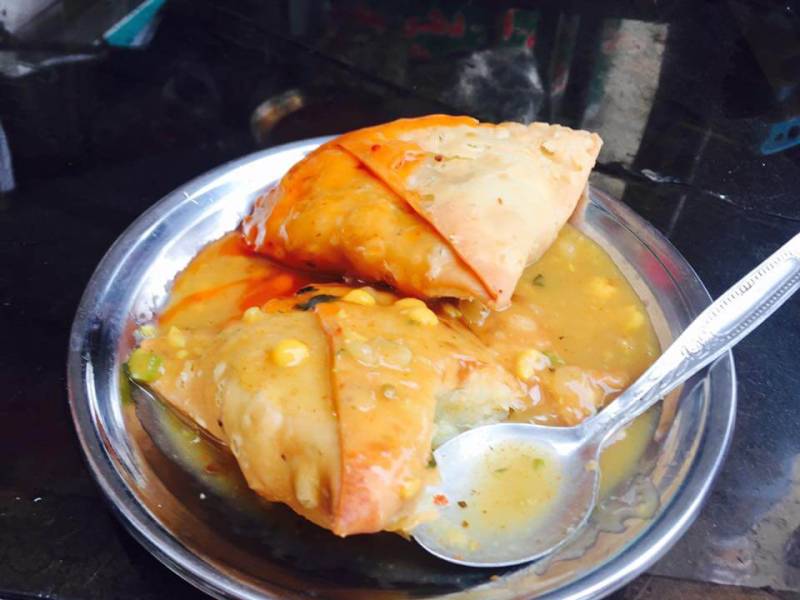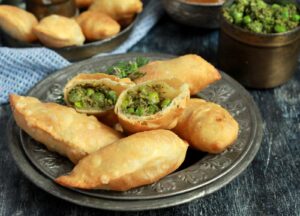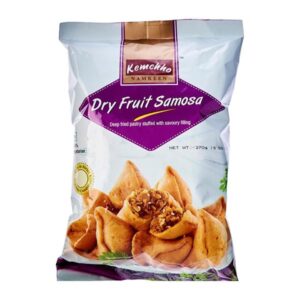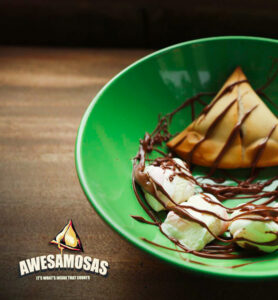
We all know and love the humble samosa, quite possibly the most popular snack all over Pakistan. A doughy triangle filled with vegetables, meats, and sometimes even fruit and chocolate. No Ramzan is complete without a plate of golden fried samosas at iftar.
There's no consensus on which samosa reigns supreme because everybody has their own preference. Some like the tiny crispy ones that come frozen so mothers all over the country can store them in their freezers to quickly fry and serve with a cup of tea when guests arrive. Others prefer the bigger flaky ones with blistered bubbles and ripples all along the surface, perfect with some channay and meethi chutney.
Whatever your desires, there is a samosa out there for you. But perhaps something that not many people know, is that South Asia is home to so many different kinds of samosas, each with its own regional twist.
Recently, a Twitter user, Kurush F Dalal, shared a thread on his samosa journey throughout his life.
https://twitter.com/Karboholic/status/1523899385507053568
According to Kurush, what we in Pakistan know simply as a keemay wala samosa, is known in Mumbai as a Bohri Samosa, made popular by the Bohri community that migrated from Persia to India. He also said that purely vegetarian samosas are an Indian invention, as the original samosa comes from West Asia, where it is known as sambusak: a turnover type pastry filled with meat.
Throughout his thread we get to know about the different kinds of samosas that exist in South Asia. For instance, in Gujarat, a kind of samosa made with a filling of green peas, is the Vatana Ghugra Samosa. It's shaped differently than the traditional triangle shaped samosa, and instead is in a half-moon shaped hand pie.

Then there is the curious sounding Jain dry fruit samosa - very tiny samosas filled with spices, dry fruit, sugar and lentils, a mixture that Kurush says keeps them from going bad.

In Bengal, samosas are known as Singadas and are sometimes even filled with peanuts and raisins. In the Deccan, they are called Lukmi, and are made with Persian influences, with a flattened square samosa patti with the slightest bit of spiced keema filling on the inside.
https://twitter.com/Karboholic/status/1523954988015259648
He also mentions that Pakistan has its own huge variety of novelty samosas, such as pizza samosas, or ones filled with Nutella. In fact, there are now dedicated restaurants that just serve a variety of samosa, such as Awesamosas, or Samosa Kitchen.

In India too, there is a variety of sweet samosas being offered. He says there are essentially three types of sweet samosa fillings: dry fruits, khoya, or malai.
If there's one thing that has become apparent in all this samosa discovery, it is that you can make a samosa out of anything really, as long as you wrap it in samosa patti and fry it till it turns deep golden all over. How will you be enjoying your samosa today?
There's no consensus on which samosa reigns supreme because everybody has their own preference. Some like the tiny crispy ones that come frozen so mothers all over the country can store them in their freezers to quickly fry and serve with a cup of tea when guests arrive. Others prefer the bigger flaky ones with blistered bubbles and ripples all along the surface, perfect with some channay and meethi chutney.
Whatever your desires, there is a samosa out there for you. But perhaps something that not many people know, is that South Asia is home to so many different kinds of samosas, each with its own regional twist.
Recently, a Twitter user, Kurush F Dalal, shared a thread on his samosa journey throughout his life.
https://twitter.com/Karboholic/status/1523899385507053568
According to Kurush, what we in Pakistan know simply as a keemay wala samosa, is known in Mumbai as a Bohri Samosa, made popular by the Bohri community that migrated from Persia to India. He also said that purely vegetarian samosas are an Indian invention, as the original samosa comes from West Asia, where it is known as sambusak: a turnover type pastry filled with meat.
Throughout his thread we get to know about the different kinds of samosas that exist in South Asia. For instance, in Gujarat, a kind of samosa made with a filling of green peas, is the Vatana Ghugra Samosa. It's shaped differently than the traditional triangle shaped samosa, and instead is in a half-moon shaped hand pie.

Then there is the curious sounding Jain dry fruit samosa - very tiny samosas filled with spices, dry fruit, sugar and lentils, a mixture that Kurush says keeps them from going bad.

In Bengal, samosas are known as Singadas and are sometimes even filled with peanuts and raisins. In the Deccan, they are called Lukmi, and are made with Persian influences, with a flattened square samosa patti with the slightest bit of spiced keema filling on the inside.
https://twitter.com/Karboholic/status/1523954988015259648
He also mentions that Pakistan has its own huge variety of novelty samosas, such as pizza samosas, or ones filled with Nutella. In fact, there are now dedicated restaurants that just serve a variety of samosa, such as Awesamosas, or Samosa Kitchen.

In India too, there is a variety of sweet samosas being offered. He says there are essentially three types of sweet samosa fillings: dry fruits, khoya, or malai.
If there's one thing that has become apparent in all this samosa discovery, it is that you can make a samosa out of anything really, as long as you wrap it in samosa patti and fry it till it turns deep golden all over. How will you be enjoying your samosa today?

